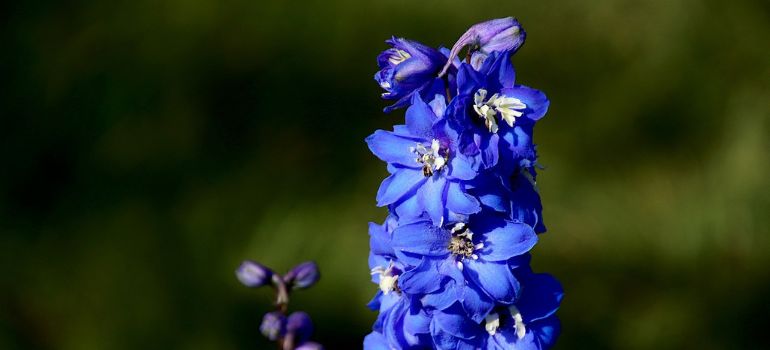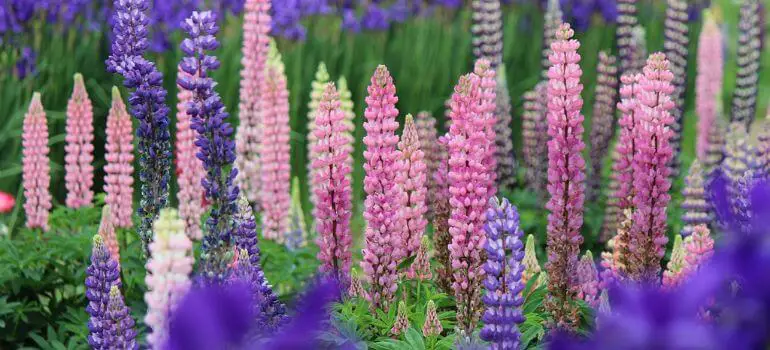Gardens are not just collections of plants; they’re living canvases where colors, shapes, and textures collide to create breathtaking displays. When it comes to adding vibrant hues and vertical interest, two contenders often stand out: delphinium and lupine. In this guide, we’ll navigate through the nuances of these botanical beauties, helping you decide which one deserves a prime spot in your garden.
Origins and Botanical Characteristics
Delphinium: A Stately Presence
Delphinium, with its towering spikes of flowers, has a regal presence in gardens worldwide. Originating from the Northern Hemisphere, these plants boast tall, sturdy stems adorned with multiple blooms. The botanical world acknowledges delphinium for its distinctive spurred flowers and deeply lobed leaves.
Lupine: Nature’s Palette
On the lupine side, we encounter a diverse genus originating from North and South America. Lupines are recognized for their palmate leaves and dense spikes of pea-like flowers. These legumes are not only visually stunning but also contribute to nitrogen fixation, enriching the soil.
Varieties and Colors
Delphinium: A Symphony of Blues, Purples, and Pinks
Delphinium offers a wide array of colors, ranging from majestic blues to soft pinks and purples. With varieties like Pacific Giants and Magic Fountains, gardeners have the liberty to choose the perfect shade to complement their outdoor spaces.
Lupine: Painting Gardens with Vibrancy
Lupines, too, come in a kaleidoscope of colors. From the classic blue lupine to the vibrant shades of pink, red, and white, these plants paint gardens with their vivid palette. Popular varieties include Russell hybrids and Gallery series.
Growing Conditions
Delphinium: A Love for Cool Climates

Delphiniums thrive in cool climates with well-draining soil. They appreciate a touch of sunlight but prefer protection from scorching heat. Ensuring good air circulation around these beauties helps prevent common issues like powdery mildew.
Lupine: Embracing Sun and Soil Diversity
Lupines, on the other hand, are more adaptable. While they love sunlight, they can tolerate a variety of soils. However, well-draining, slightly acidic soil is their preferred choice.
Caring for Delphinium and Lupine
Maintaining the health and beauty of these plants involves a few essential steps:
- Watering: Both delphinium and lupine benefit from consistent watering, especially during dry spells. However, waterlogging should be avoided to prevent root rot.
- Fertilizing: Providing a balanced fertilizer during the growing season promotes robust growth and abundant blooms.
- Pests and Diseases: Keep an eye out for pests like aphids and slugs. Delphiniums are susceptible to powdery mildew, while lupines may face challenges from aphids and spider mites.
Landscaping Uses
Designing with Delphinium
Delphiniums, with their towering spikes, make excellent background plants. They add vertical interest to borders and work well in cottage gardens. Their diverse colors allow for creative landscaping designs.
Lupine’s Aesthetic Appeal
Lupines, with their bushy habit, create a charming mid-height layer in garden designs. They’re ideal for mass plantings and can be used to create a wildflower meadow effect.
Height and Size Differences
Delphinium: Reaching for the Sky
Delphiniums are known for their height, often reaching 3 to 6 feet or even taller. This makes them suitable for the back of flower beds, where their spires can create a dramatic effect.
Lupine: A Mid-Height Marvel
Lupines typically range from 1 to 4 feet in height, offering a mid-height alternative for gardeners with limited space. Their compact size makes them versatile in various garden layouts.
Blooming Seasons
Delphinium and Its Summer Elegance
Delphiniums bloom primarily in early to mid-summer, adding an elegant touch to your garden during this season. Deadheading spent blooms can encourage a second flush of flowers.
Lupine’s Spring Extravaganza
Lupines steal the show in late spring to early summer. Their spires of flowers create a captivating display, heralding the arrival of the warmer months.
Popularity in Gardens
Delphinium’s Timeless Allure
Delphiniums have long been cherished in gardens for their timeless beauty. Their association with cottage gardens and traditional landscapes has kept them in the spotlight.
Lupine’s Resurgence
While lupines may have taken a back seat for a while, they are experiencing a resurgence in modern gardens. Their versatility and ability to attract pollinators make them a favorite among contemporary gardeners.
Symbolism and Cultural Significance
Delphinium: A Symbol of Swiftness
Delphiniums have symbolic importance, representing swiftness and lightness of being. In various cultures, they are associated with positive traits like openness and a pure heart.
Lupine: Symbolizing Imagination
Lupines symbolize imagination and creativity. In some cultures, they are linked to imagination and the endless possibilities it brings.
Challenges in Growing
Delphinium’s Susceptibility to Pests
Delphiniums, while stunning, can be prone to pests like aphids and caterpillars. Powdery mildew is also a common challenge, especially in humid conditions.
Lupine’s Need for Well-Drained Soil
Lupines are generally hardy but can struggle in waterlogged soil. Ensuring well-drained conditions is crucial to prevent root rot and other soil-related issues.
Hybrid Varieties
Delphinium: Exploring Hybrid Beauty
Hybrid delphinium varieties offer a fusion of colors and improved characteristics. Look out for the Belladonna and Guardian series for unique blooms.
Lupine: Unique Features of Hybrid Varieties
Hybrid lupines often exhibit enhanced traits, such as more compact growth habits and extended blooming periods. The Popsicle series is known for its vibrant colors and dwarf size.
Comparison of Maintenance Efforts
Analyzing Delphinium’s Elegance and Demands
While delphiniums demand attention to prevent pest and disease issues, their majestic presence and stunning blooms make the effort worthwhile.
Choosing Lupine for Low-Maintenance Charm
Lupines, being more adaptable, require less fuss. Their resilience and ability to thrive in diverse conditions make them an excellent choice for low-maintenance gardens.
Eco-Friendly Gardening Practices
Sustainable Delphinium Cultivation
To cultivate delphiniums sustainably, consider organic fertilizers and integrated pest management. These practices reduce environmental impact while maintaining the health of your garden.
Lupine: Enhancing Biodiversity
Lupines contribute to biodiversity by attracting pollinators. Embrace eco-friendly gardening by incorporating lupines and supporting local ecosystems.
Conclusion
In the delightful clash of delphinium vs. lupine, both plants bring unique characteristics to the table. Delphiniums dazzle with their height and elegant blooms, while lupines enchant with their versatility and ecological contributions. Consider your garden’s needs, your space constraints, and your aesthetic preferences when choosing between these botanical wonders.
Get ready to transform your garden into a canvas of colors and textures by welcoming the beauty of delphiniums and the charm of lupines.
FAQs: Your Queries Answered
Yes, they can complement each other well, creating a dynamic and colorful garden display.
Taller varieties may benefit from staking to support their stems and prevent bending.
Lupines prefer regular watering, especially during dry spells, but avoid waterlogged conditions.
Yes, delphiniums contain alkaloids that can be toxic to pets if ingested. Keep them out of reach.
Yes, lupines can thrive in containers, provided they have well-draining soil and receive adequate sunlight.



